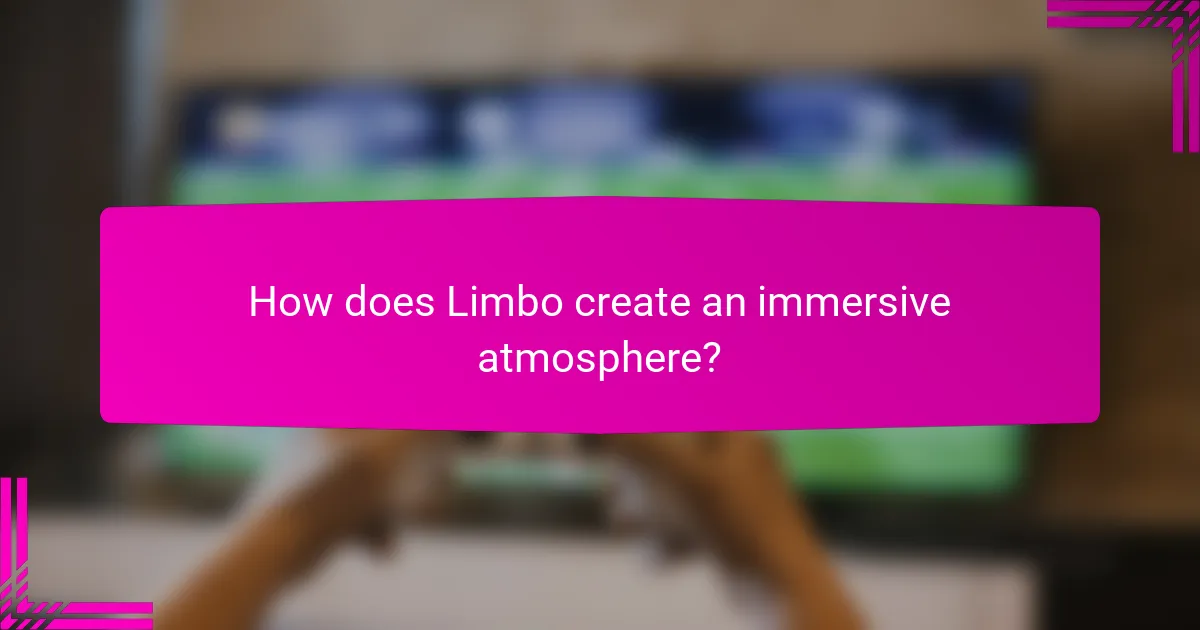Limbo captivates players with its immersive atmosphere, intricate puzzle integration, and compelling narrative techniques. The game’s unique art style and sound design create a haunting environment. Puzzle mechanics enhance exploration and engagement, while narrative elements unfold subtly, deepening emotional connections. This article examines how these aspects intertwine to create a memorable gaming experience.

How does Limbo create an immersive atmosphere?
Limbo creates an immersive atmosphere through its unique art style, sound design, and narrative integration. The monochromatic visuals evoke a sense of isolation, while ambient sounds enhance emotional depth. Puzzle integration encourages exploration, making players feel part of the environment. Narrative techniques subtly unfold the story, deepening engagement and connection.
What role does visual design play in Limbo’s ambiance?
Visual design is crucial in shaping Limbo’s eerie ambiance. It employs stark contrasts and muted colours to evoke feelings of isolation and unease. The minimalist aesthetic enhances puzzle integration, guiding players through the narrative without distractions. Unique attributes like the fluid animation style contribute to a dreamlike quality, immersing players deeper into the game’s world. The visual elements work harmoniously with sound design, reinforcing the overall atmosphere and emotional impact.
How does sound design enhance the player’s experience in Limbo?
Sound design significantly enhances the player’s experience in Limbo by creating an immersive atmosphere that complements the visual elements. The eerie soundscapes evoke feelings of tension and isolation, which are central to the game’s narrative.
Puzzle integration is enhanced through audio cues that guide players in solving challenges. For example, specific sounds signal the presence of obstacles or hint at solutions, enriching gameplay and fostering intuition.
Moreover, the minimalist sound design aligns with the game’s unique aesthetic, reinforcing the haunting themes and emotional depth. This synergy between sound and visuals creates a cohesive experience that deeply engages players.
Ultimately, Limbo’s sound design not only supports but elevates its narrative techniques, making the player’s journey more impactful and memorable.
What emotional responses are elicited by Limbo’s atmospheric elements?
Limbo’s atmospheric elements evoke feelings of isolation, tension, and curiosity. The stark visuals and haunting soundscapes create a sense of unease, enhancing the player’s emotional engagement. The minimalist design fosters introspection, while the puzzles challenge cognitive abilities, deepening the emotional investment in the narrative. This combination of visual and auditory elements uniquely contributes to a profound emotional response throughout the gameplay experience.

What are the key puzzle integration techniques in Limbo?
Limbo employs several key puzzle integration techniques that enhance gameplay and storytelling. These techniques include environmental storytelling, physics-based puzzles, and player-driven exploration.
Environmental storytelling immerses players in a haunting atmosphere, using the surroundings to convey narrative elements. Physics-based puzzles require players to manipulate objects and navigate obstacles, fostering critical thinking. Player-driven exploration encourages discovery, allowing players to engage with the game world at their own pace, deepening their connection to the narrative.
These integration techniques create a cohesive experience that intertwines atmosphere, puzzles, and narrative, making Limbo a unique title in the gaming landscape.
How do environmental puzzles contribute to gameplay progression?
Environmental puzzles in Limbo enhance gameplay progression by challenging players to think critically and engage with the game’s atmosphere. These puzzles integrate seamlessly into the narrative, requiring players to solve them to advance the story. The unique design of each puzzle often reflects the game’s dark and immersive environment, reinforcing the overall theme. As players navigate these challenges, they experience a sense of accomplishment that drives further exploration and emotional investment in the narrative.
What unique mechanics are employed in Limbo’s puzzles?
Limbo employs unique mechanics like physics-based interactions, environmental manipulation, and light and shadow dynamics in its puzzles. These elements create a distinct gameplay experience that challenges players’ problem-solving skills. For example, players must navigate through obstacles using gravity and momentum, enhancing the immersive atmosphere. The puzzles often require players to think outside the box, utilising the game’s eerie aesthetics to find solutions.
How does puzzle difficulty evolve throughout the game?
Puzzle difficulty in Limbo gradually increases as players progress. Early puzzles introduce basic mechanics, while later challenges require advanced problem-solving and critical thinking. The game’s atmosphere enhances this evolution, creating tension and urgency. Unique attributes, such as environmental interactions and narrative integration, further complicate puzzles, ensuring a rewarding experience.

In what ways does Limbo utilize narrative techniques?
Limbo employs narrative techniques through environmental storytelling, emotional ambiance, and character-driven puzzles. These elements immerse players in a haunting world, enhancing the overall experience. The game’s use of visual cues and sound design creates a rich atmosphere that conveys themes of isolation. Additionally, puzzles often reflect the narrative arc, intertwining gameplay with story progression. This integration reinforces the player’s emotional connection to the protagonist’s journey.
How is storytelling conveyed without dialogue in Limbo?
Storytelling in Limbo is conveyed through visual cues, environmental design, and character actions. The game’s monochromatic art style creates a haunting atmosphere that enhances emotional storytelling. Players interpret narrative elements through the protagonist’s journey and interactions with the environment. Symbolic imagery, such as shadowy figures and obstacles, conveys themes of fear and survival without the need for dialogue. The integration of puzzles further enriches the narrative, as solving them reveals deeper layers of the story and the character’s struggles.
What themes are explored through Limbo’s narrative structure?
Limbo’s narrative structure explores themes of isolation, perseverance, and the human condition. The atmospheric design enhances emotional engagement, while puzzle integration reflects the protagonist’s struggle. Unique narrative techniques, such as minimalist storytelling and a non-linear progression, deepen the player’s connection to the experience.
How does player agency influence the narrative experience in Limbo?
Player agency significantly enhances the narrative experience in Limbo by allowing players to make choices that shape the story. This interactive element fosters emotional investment and immersion. Players navigate a haunting world filled with environmental puzzles that reflect their decisions. The atmosphere heightens the tension, making each choice impactful. Unique narrative techniques, such as minimal dialogue and visual storytelling, further deepen player engagement. As a result, the player’s journey through Limbo becomes a personal and memorable experience.

What cultural influences are reflected in Limbo’s design?
Limbo’s design reflects various cultural influences, notably through its atmospheric elements and narrative techniques. The game draws from German Expressionism, evident in its stark contrasts and surreal environments. Additionally, it incorporates themes of childhood innocence and existentialism, resonating with broader cultural narratives. The use of shadow and light enhances the emotional depth, creating a haunting ambiance that speaks to universal human experiences.
How does Limbo draw from folklore and mythology?
Limbo draws heavily from folklore and mythology, weaving rich narratives and atmospheric elements into its gameplay. The game incorporates themes from various cultural myths, creating a sense of intrigue and depth. For example, the use of shadowy figures and eerie landscapes evokes traditional tales of spirits and the afterlife. This integration enhances the puzzle mechanics and narrative techniques, making the player experience more immersive. Additionally, the unique visual style reflects the essence of folklore, where every detail contributes to the overall storytelling.
What regional artistic styles inform Limbo’s visual presentation?
Limbo’s visual presentation is influenced by regional artistic styles, particularly German Expressionism and Surrealism. These styles contribute to the game’s atmospheric depth and emotional resonance. German Expressionism’s stark contrasts and distorted forms enhance the game’s eerie landscapes. Surrealism’s dreamlike qualities inform the game’s narrative and puzzle design, creating an immersive experience. The combination of these artistic influences shapes Limbo’s unique aesthetic.

Which aspects of Limbo’s gameplay are most innovative?
Limbo’s gameplay innovates through its atmospheric design, seamless puzzle integration, and unique narrative techniques. The game’s monochromatic visuals create a haunting environment that enhances immersion. Puzzles are intricately woven into the narrative, requiring players to think critically about their surroundings. Moreover, the use of environmental storytelling engages players emotionally, making each challenge feel significant. These elements collectively redefine traditional gameplay mechanics, offering a fresh experience.
What sets Limbo apart from other indie games in terms of mechanics?
Limbo stands out among indie games due to its unique atmospheric design, seamless puzzle integration, and compelling narrative techniques. The game employs a monochromatic visual style that creates a haunting environment, enhancing player immersion. Its puzzles are intricately woven into the gameplay, requiring players to think critically while maintaining engagement with the story. Limbo’s narrative unfolds without dialogue, relying on visual storytelling, which is a rare attribute that sets it apart from other titles. This combination of mechanics fosters a distinct player experience that emphasizes exploration and emotional impact.
How do player interactions with the environment create unique experiences?
Player interactions with the environment in Limbo create unique experiences through immersive atmosphere, intricate puzzles, and compelling narrative techniques. The dark, moody visuals and sound design establish an unsettling ambiance that enhances emotional engagement. Players navigate through environmental puzzles that require observation and experimentation, fostering a sense of discovery. The narrative unfolds subtly, encouraging players to interpret events through their interactions rather than explicit storytelling. This combination of elements results in a distinctive gameplay experience that emphasizes exploration and emotional resonance.

What lessons can developers learn from Limbo’s success?
Developers can learn valuable lessons from Limbo’s success, particularly in atmosphere, puzzle integration, and narrative techniques. The game’s distinctive atmosphere is achieved through minimalistic visuals and sound design, creating an immersive experience. Effective puzzle integration enhances gameplay by seamlessly blending challenges with the narrative, ensuring player engagement. Additionally, strong narrative techniques, such as environmental storytelling, deepen emotional connections and enhance player investment. These elements combined demonstrate the importance of cohesive design in creating memorable gaming experiences.
What best practices can be derived from Limbo’s atmospheric design?
Limbo’s atmospheric design emphasizes immersion, emotional engagement, and puzzle integration. Best practices include using visual storytelling, minimalistic soundscapes, and environmental cues to guide player interaction. These elements create a cohesive experience that enhances narrative depth. Additionally, leveraging contrast between light and dark can evoke specific emotions, enriching the overall gameplay.
How can puzzle integration be optimized in game design?
Puzzle integration can be optimized in game design by ensuring puzzles enhance the narrative and atmosphere. Effective puzzle design aligns with gameplay mechanics, providing challenges that feel organic within the game world.
Utilising environmental storytelling can deepen engagement, as players solve puzzles that reveal lore or character motivations. Incorporating varied puzzle types maintains player interest and caters to different problem-solving styles.
Feedback mechanisms, such as visual or auditory cues, reinforce player success and encourage exploration. Balancing difficulty is crucial; puzzles should be challenging yet solvable, promoting a rewarding experience.
Finally, playtesting is essential to refine puzzle integration, ensuring it resonates with the intended audience and enhances overall gameplay.
What common pitfalls should be avoided in narrative-driven games?
Common pitfalls in narrative-driven games include poor pacing, lack of player agency, and inconsistent world-building. These issues can detract from immersion and engagement.
1. Poor pacing disrupts narrative flow and can lead to player frustration.
2. Lack of player agency limits emotional investment and reduces replayability.
3. Inconsistent world-building creates confusion and undermines story credibility.
4. Overly complex puzzles can alienate players and break narrative immersion.
5. Neglecting character development can result in unrelatable protagonists and weak emotional connections.
